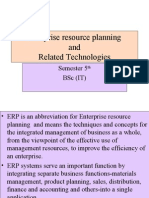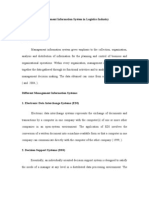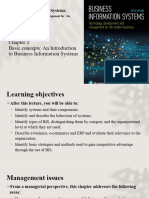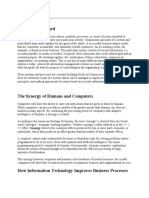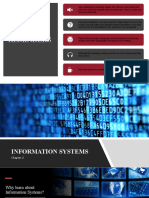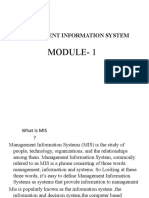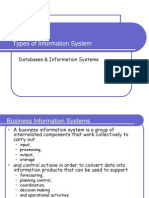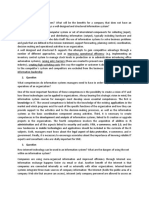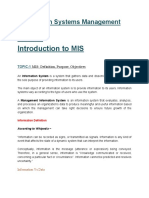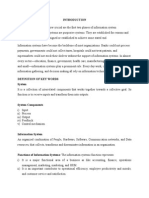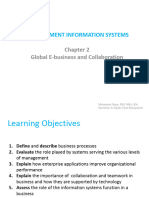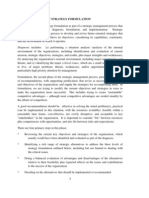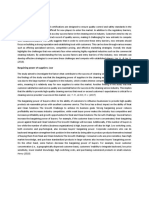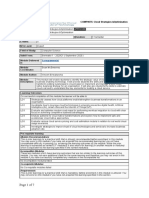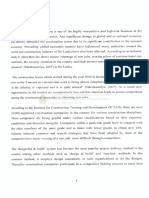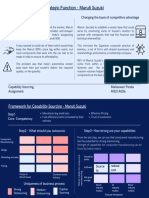Introduction to
Business Information
Systems
Chapter 2
Dr. Zin Maung Maung
Ph.D.(IT), MBA(MUE), M.E.(Japan)
1
�Chapter 2 - Contents
2
�What is a system?
• A system can be defined as a collection of interrelated components
that work together towards a collective goal. The function of a system
is to receive inputs and transform these into outputs.
• Business systems often have multiple goals such as profit or
improving the quality of a product. The overall goal of a business is
often described within a mission statement.
3
�Generic model of a system
4
�5
�Other System Characteristics
• All systems share these characteristics:
• The components of a system work towards a collective goal. This is known as the
system’s objective. The objective of a system is normally very specific and can
often be expressed in a single sentence. As an example, the objective of a car
might be expressed simply as to transport people and goods to a specified
location.
• Systems do not operate in complete isolation. They are contained within an
environment that contains other systems and external agencies. The scope of a
system is defined by its boundary.
• Everything outside of the boundary is part of the system’s environment,
everything within the boundary forms part of the system itself. The boundary also
marks the interface between a system and its environment. The interface
describes exchanges between a system and the environment or other systems.
6
�Subsystems, suprasystem
• Systems can be complex and can be made up of other smaller
systems. These are known as subsystems.
• Systems composed of one or more subsystems are sometimes
referred to as suprasystems.
• The objective of a subsystem is to support the larger objective of the
suprasystem.
• Suprasystem - A larger system made up of one or more smaller
systems (subsystems).
7
�Open and closed systems
• Systems that have a high degree of interaction with the environment
are called open systems. Open systems are influenced by changes in
the environment and can also influence the environment itself. Most
information systems are open systems because they accept inputs
and react to them.
• Totally closed systems which do not interact with their environment
are unusual.
• Subsystems in an information system interact by exchanging
information. This is known as the interface between systems.
8
�Coupling
• The linkage or coupling between subsystems varies. The degree of
coupling defines how closely linked different subsystems are. It is a
fundamental principle of systems theory and BIS design that
subsystems should be loosely coupled.
• Systems or subsystems that are highly dependent on one another are
known as close-coupled systems. In such cases, the outputs of one
system are the direct inputs of another.
• As an example, consider the way in which an examination system
might operate. The letter that confirms a student’s grade could be
said to be the result of two subsystems working together very closely.
9
�JIT as an example of close-coupled system
• The ‘just-in-time’ method used by a number of manufacturing
organisations also illustrates a close-coupled system well. This
method involves holding as few parts or raw materials as possible. In
order to ensure that production is not halted, parts must be supplied
‘just in time’ to be used in the manufacturing process. Unless the
manufacturing organisation has very close links with its suppliers, this
approach cannot work effectively.
10
�Decoupled systems
• Decoupled systems (or subsystems) are less dependent on one
another than coupled systems and so are more able to deal with
unexpected situations or events. Such systems tend to have higher
levels of autonomy, being allowed more freedom to plan and control
their activities.
• Although decoupled systems are more flexible and adaptive than
close-coupled systems, this very flexibility increases the possibility
that inefficiencies might occur. The traditional method of production
where material is held ‘in-hand’ as inventory is decoupled. In this
arrangement it is not necessary for production to match sales so
closely, but this results in higher costs of holding inventory.
11
�BIS as an organizational control mechanism
12
�Open-loop control system
• An open-loop control system is one in which there is an attempt to reach the
system objective, but no control action to modify the inputs or process is taken
once the process has begun.
13
�14
�15
�16
�17
�Different types of systems
• In a deterministic system (sometimes known as mechanistic), all of
the system’s outputs can be predicted by examining its inputs. An
example of a deterministic system is an electronic calculator, where
the results of carrying out a calculation can be predicted with
complete accuracy.
• In a probabilistic system (sometimes known as stochastic), the
outputs of the system cannot be predicted with complete accuracy.
An example of a probabilistic system is a production planning system
used to schedule work. Although the system can predict how long the
production run is likely to take, it cannot provide a precise figure. An
example of an information system of this type is a sales forecasting
system.
18
�Adaptive system
• An adaptive system (sometimes known as ‘self-organising’ or
‘cybernetic’) responds to changes in the environment and modifies its
operation accordingly.
• The outputs obtained from the system are sometimes uncertain since
the system may respond to the same stimuli in a different way.
Examples of adaptive systems include human beings, plants and
business organizations.
19
�Hard and soft systems
• A hard system has an explicit objective and is governed by fixed rules
and procedures such as those encountered for structured decision
making (Chapter 1).
• The conditions in the system’s environment tend to be stable and
therefore more predictable. In turn, the system’s outputs can be
predicted more easily and its performance can be measured
objectively. An example of a hard system is a production line.
• A soft system operates in a relatively unpredictable environment
where conditions may be uncertain or liable to rapid change. Soft
systems usually involve people or socio-technical situations.
20
�21
�22
�Computerized BIS
• In modern organizations, most BIS make extensive use of information
technology, such as personal computers. The reasons why
computerized BIS have become widespread are evident in their
advantages.
23
�24
�25
�26
�27
�28
�29
�30
�31
�32
�Enterprise systems
• Enterprise systems aim to support the business processes of an
organization across any functional boundaries that exist within that
organization.
• They use Internet technology to integrate information within the business
and with external stakeholders such as customers, suppliers and partners.
• The main elements of an enterprise system are enterprise resource
planning (ERP) which is concerned with internal production, distribution
and financial processes, customer relationship management (CRM) which is
concerned with marketing and sales processes, supply chain management
(SCM) which is concerned with the flow of materials, information and
customers through the supply chain and supplier relationship management
(SRM) which is concerned with sourcing, purchasing and the warehousing
of goods and services.
33
�34
�35
�36
�37
�38
�39
�Discussion Topics
• How can organizations utilize Business Information Systems
to gain Competitive Advantage over competitors? Explain by
giving examples.
• Can Business IT Systems improve organizational
performance? Explain by using example organizational
scenarios.
40
�41
�42
�BIS and Competitive Advantage
• Michael Porter’s work can also be used to identify a number of ways
in which BIS can be used to counter the five competitive forces and
achieve competitive advantage.
• These include:
• improving operational efficiency
• raising barriers to entry
• locking in customers and suppliers
• promoting business innovation
• increasing switching costs
• leverage
43
�44
�Improving operational efficiency
• One of the most common ways of using computer-based information
systems to achieve competitive advantage is by using them to improve
operational efficiency.
• As an example, consider a typical manufacturing company wishing to adopt
a cost leadership strategy. In a primary activity, such as production, an
inventory control system might be used to manage stock levels, reducing
storage and transportation costs. In addition, support activities, such as
management and administration, might achieve higher levels of
productivity through the introduction of office automation systems.
• The organisation might also realise additional benefits from this kind of
approach, such as improved customer service.
45
�Barriers to entry
• In many industries, organisations have improved operational efficiency by investing
heavily in BIS. Often, the systems employed are extremely complex and require ongoing
maintenance and development.
• This means that newcomers to the industry must be prepared to make a large initial
expenditure so that they can acquire the computer-based information systems they need
to be able to compete effectively. The level of expenditure needed may be so high that
an entry barrier is created that deters or prevents the new competitor from entering the
industry.
• Investing heavily in computer-based information systems may also deter existing
competitors, since they too must invest in their information systems in order to maintain
or improve their position in the industry. New technologies can decrease barriers to
entry. For example, electronic banking removed the requirement for a branch network,
leading to the establishment of Internet-only banks, such as Smile.
• However, entry barriers were so high that most required the backing of a major high-
street bank or building society.
46
�Locking in customers and suppliers
• Linking an organization's computer-based information systems to those of
its customers and suppliers can help to strengthen business relationships.
• As an example, computer-based information systems can be used to
provide higher levels of customer service, thereby encouraging clients to
remain loyal to the company.
• Close integration with a supplier’s information systems can result in a
number of business benefits, which include:
• the availability of raw materials or parts is more certain
• cost savings can be realized through reduced administration overheads
• suppliers are less likely to abandon the business relationship
• the organization can negotiate favorable terms and prices
• competitors are excluded from the business relationship
47
�Promoting business innovation
• Investing in computer-based information systems often helps to stimulate
business innovation. Introducing a new process control system, for
example, might ultimately result in the development of new product
features or new product lines.
• Organizations that have invested in building effective computer-based
information systems are well placed to support business innovation. Such
organizations are likely to have established a resource base that can be
drawn upon to develop new ideas.
• On the other hand, an organization that has failed to invest adequately in
its information systems may lack essential resources, such as hardware,
software and trained personnel, and be unable to explore new methods.
48
�Increasing switching costs
• In general, an organization that has invested time, money and effort
in developing a computer-based information system will be reluctant
to bear the switching costs of moving to a new system.
• In addition to the cost of new hardware and software, a range of
other costs can be incurred. These might include costs connected
with:
• converting data for use with the new system
• training staff
• interruptions to the company’s operations
• lost opportunities to gain new business
49
�Increasing switching costs
• When an organization links its information systems to those of its
suppliers or customers, it will often ensure that switching costs are as
high as possible.
• In this way, the supplier or customer is discouraged from switching to
a competitor’s system and competitors are excluded from the
business relationship.
50
�51
�Summary
52
�Summary
53
�Summary
54









